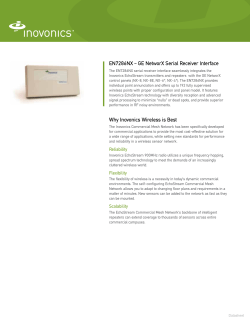
3D Wireless NetworkâonâChip Architecture with interlayer cooling
3D Wireless Network‐on‐Chip Architecture with interlayer cooling ‐‐Md Shahriar Shamim & Fernando Cueva 5/6/2015 1 Overview • Introduction • Multi‐core chip • Network‐on‐Chip • 3D NoC • Thermal Challenges • Why 3D Wireless? • Proposed Architecture • Results • Conclusion 5/6/2015 2 Multi‐core Chips: A Necessity • Need for explosive computational power • Consumer/Entertainment Application • Scientific Application • Increasing clock frequency is not possible as it increases power dissipation Solution: Core level Parallelism, distribute tasks to multiple cores 5/6/2015 3 Challenges: Interconnection of Cores • Traditional Interconnect architectures are not scalable • Delay limit number of cores Solution: Scalable interconnect infrastructure for communication 5/6/2015 4 Network‐on‐Chip (NoC) • Packet based on‐chip network • Route packets, not wires –Bill Dally, 2000. • Dedicated infrastructure for data transport • Decoupling of functionality from communication • A plug‐and‐play network independent of the cores High-performance ARM processor High-bandwidth memory interface High-bandwidth ARM processor AHB B R I D G E Timer UART APB Keypad PIO DMA Bus master AMBA bus: ARM NoC infrastructure Multiple publications in IEEE ISSCC, 2010 from Intel, IBM, AMD, and Sun Microsystems show that multi-core NoC is a reality 5/6/2015 5 5 Problem with Traditional wire Interconnect • Limitation of Wireline Interconnect • Multi‐hop wireline communication • High Latency and energy dissipation source destination -core -NoC interface -NoC switch 80% of chip power will be from on-chip interconnects in the next 5 years – ITRS, 2007 5/6/2015 6 6 Emerging Interconnect Technologies Goal: High Bandwidth + Low Energy Dissipation Three Dimensional Integration Wireless Interconnects Optical Interconnects 5/6/2015 7 7 3D Integration • Stacking multiple active layers • Heterogeneous integration • Higher connectivity & less hop count High bandwidth • Shorter average path length Lower Power Challenges • High power densities • Thermal issues • High temperatures • Hotspots • Limited ability to extract heat only from top or bottom layer • Pavlidis et al., “3-D topologies for Networks-on-Chip”, IEEE Transactions on Very Large Scale Integration (TVLSI), 2007. 5/6/2015 8 8 Micro‐channel based Sophisticated Cooling Layer • Microchannels between active layers circulating with chilled fluids • What about TSVs? • • • pumping liquid can cause extreme pressure drops across the cooling layer ‐‐> structural instability. Complex manufacturing process as the TSVs and micro‐channels will co‐ exist between the cooling layer. Longer TSVs ‐‐> Higher delay and power dissipation SABRY et al. Energy-Efficient Multiobjective Thermal Control for Liquid-Cooled 3-D Stacked Architectures. Trans. Comp.-Aided Des. Integ. Cir. Sys. Vol:30, Issue:12, page(s): 1883-1896 5/6/2015 9 What should we do? Can incorporating another emerging interconnect technology fix these problems?? Maybe Photonic???Wireless? What about wireless?? It does not need any physical interconnect layout. Hmm, it can alleviate the height limitation of the cooling layer.. 5/6/2015 But Photonic interconnect also requires dedicated physical layout like TSVs.. 10 10 Wireless Interconnect • Use of on‐chip wireless links • Single Hop Shortcut • Reduce latency and energy dissipation in communication • No physical interconnect layout is necessary • Wireless port/wireless interface (WI) consists of transceiver and antenna • Antenna Technology: • Metal zigzag antennas (mm‐wave) are CMOS compatible J. Lin et al., “Communication Using Antennas Fabricated in Silicon Integrated Circuits,” IEEE Journal of Solid-State Circuits, vol. 42, no. 8, August 2007, pp. 1678-1687. 5/6/2015 11 Proposed Architecture • Hierarchical in nature • Two level Hierarchy • Bottom layer • Mesh Connectivity • Upper layer • Switches grouped into subnets • One hub per subnet • All switches from one subnet connected to the hub from that subnet • One wireless per subnet • Wireless interconnected with each other in all‐to‐all fashion 5/6/2015 12 Performance Evaluation of 3D Wireless NoC CANNEAL • 4 layers • 8 wireless routers • 2 in each layer • 2 MAC protocols • Token based • CDMA Peak temperature (ºC) • 64 cores FFT LU RADIX BODYTRACK 80 70 60 50 40 30 20 10 0 3D‐Mesh‐TSV CDMA based 3D‐HiWiNoC Fig. Peak temperature in presence of real application traffics • Lower temperatures for several benchmarks Lower packet energy, lower temperature, comparable bandwidth 5/6/2015 13 Performance Evaluation of 3D Wireless NoC • What about bandwidth and energy? BW(3D‐Mesh_TSV) BW(CDMA based 3D‐HiWiNoC) Packet Energy(3D‐Mess‐TSV) Packet Energy(CDMA based 3D‐HiWiNoC) Normalized Peak Bandwidth 1 1 0.8 0.8 0.6 0.6 0.4 0.4 0.2 0.2 Normalized Packet Energy 1.2 1.2 0 0 CANNEAL FFT LU RADIX BODYTRACK Fig. Peak temperature in presence of real application traffics Lower packet energy, lower temperature, But bandwidth is also reducing. Why?? 5/6/2015 14 Why 3D wireless NoCs with interlayer cooling suffers from bandwidth degradation? • Number of active links in wireless architecture is less than 3D wireline mesh in order to accommodate micro‐channel liquid cooling layer. • In 64 core 4 layer system,16 TSV based links connecting the vertically adjacent switches across the cooling layer is eliminated. • Results in a loss of an aggregate bisection bandwidth of 1.2Tbps. • Wireless bandwidth is only 16GBps. Limitation??? 5/6/2015 15 Conclusion • Interlayer Wireless Interconnects • Eliminate TSVs across the cooling layer • Make cooling layers modular in design • Improves pressure drops and thermal efficiencies • Improvement in peak temperature reduction and energy efficient. • However, suffers from Bandwidth degradation. • Requires performance evaluation of interlayer communication 5/6/2015 Finally!!! 16 Questions??? 5/6/2015 17
© Copyright 2025
![[WCR-300S] How to Change the Wireless Network Name(SSID)](http://cdn1.abcdocz.com/store/data/000232989_1-c13ffbaf9a88e423608ef46454e68925-250x500.png)









